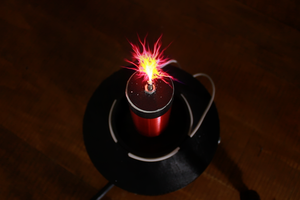Tesla Coil - Scientific way
There are a lot of information about Tesla coils, but still it's tricky to build/tune one. Here we would like to go over and explain ...
There are a lot of information about Tesla coils, but still it's tricky to build/tune one. Here we would like to go over and explain ...
To make the experience fit your profile, pick a username and tell us what interests you.
We found and based on your interests.
|
Portable Network Graphics (PNG) - 106.15 kB - 06/06/2023 at 20:44 |
|
|
I've already made all the stages and it was powerful enough to lit 18W fluorescent bulb, but I failed to make the plasma flame. I've burned so many MOSFETs, it was so exhausting,I was about to give up. And then I got idea. Why don't i reverse engineer a device I have. This way I could be sure where is the problem. Using the ideas and techniques I wrote on my previous post I made my own DIY output coil. Voila! It worked
Few important things one can learn here. Device unloaded frequency and coil self frequency can differ even in one mega Hertz and it will be ok. 200KHz is what you see. Most interesting fact is that final output is not frequency where it's getting lower oscilloscope reading but where it gets higher.
Just to make sure we are on the same page here, 200KHz equal to reducing one or two turns in 30mm diameter coil. Reducing the output wire by centimeter also increases the output frequency by 100KHz. Adding metallic discharge nut/bolt may reduce by 500KHz. Pulling the wire up will reduce frequency.
As you see there is a lot of ways to change frequency of output coil, one thing certain once you fix the frequency make sure nothing moves.
Another thing is to add output termination otherwise copper wire will burn once power is high enough, be aware...
Now it's time for connecting all together, Oh la la, nothing is working! What happened? It looks like my main circuit is on 200Volt instead of 1KV! What why? Oh! I forgot I used some old MOSFETs from unknown source some of them are bad and vary greatly in specs. I don't believe I felt twice on same mistake.
Bought another bunch of IRFP260N MOSFETs, fingers crossed!
Stay tuned! 😁
I changed the main coil from 32mm to 60mm. Same induction value. Tested, working as expected. Yeay! Now I want to make bigger secondary coil, instead of quarter wave. Hopefully get more power.
Let's see how much more voltage we get once we have more turns.
It's interesting and not what I've expected.
If I use coil with wire length of 1/4 wave length I got 660v (and clean sine wave) on the other hand using longer wire of 3/4 wave length gets only 520v and distorted signal.
I'll try to make a list of wire length (in wave length) vs max voltage across the coil:
1/4: 660v
1/2: 460v
What?! It doesn't make sense, bigger coil is more voltage at least it how it works in transformers.
So, I've tried different approach. Connected coil to 1khz pulses and was looking for oscillation but got oscillation of about 500khz not what I have expected.
Clueless again...
[Two hours later]
New tactic, let's try to create frequency sweep using Arduino and AD9833 frequency generator. I will try amplify the signal using A-class 2n2222 transistor. Check the output of coil to determine if we hit self resonance frequency. If this will not work I will be totally clueless... like totally clueless...
This is the digital part that can change frequency from 0 to 12MHz (based on AD9833)
Now I should add 2n2222 transistor to drive a coil with 600mA instead of few mA.
The best way is to start with simulation. LTSPICE solution
Which gives, although simulated, 4v to 22v swing and gives 400mA max. Which is far enough from 500mA rms and powerful enough to drive a coil.
I've noticed that 50ohm resistor can get lots of power since there is almost 0.5v Vpp.
So, which power rating for resistor should I use? Well converting 0.5Vpp gives about 0.14v rms and by I^2R = P we get about 1Watt.
Ok, made the circuit
It's very ugly since all high current is not on a breadboard. It's far from 22v swing actually only 2v. But once it gets the right frequency the coil got unbelievable 14.2v.
Now we can craft coil with self resonance of 10MHz.
Using AD9833 was a mistake, first it cannot go beyond 12MHz. Second, it's output is low and varies greatly over different frequencies.
So I've changed it to Si5351 although it's only square signal generator the output from 2n2222 was 17-24Vpp. This powerful signal generator helped me to distinguish between noise and real self resonance.
Solved that, now new problem arised. Since coil self capacitance is about 1.5pF, the capacitance of the probes changing the frequency. I guess I should use well known capacitor to find coil's inductance from resonance frequency. Once I have this I will assume 1.5pF and try to figure out which coil is should make so it's self resonance frequency is 10.4MHz
I've started from cylinder diameter D=3cm wire diameter 0.3mm and wrapped about 90turns which gave me coil height of 3cm. From there I started to remove turn by turn to find the self resonance frequency. At 2.8cm coil height I started to see discharge (plasma) but it also done some strange noise from the coil. Removing more turns at 2.6cm coil height I got maximal discharged and I could start it without touching it with a metallic object.(Which is nice since I don't want to start it by touching it, it's much better to ignite it by changing the voltage) plus the current consumption from power supply dropped from 1.2A to 0.2A. Removing more coil turns I got to 2.4cm height of coil the discharge become weaker and chirping noise returned. Down from there it couldn't produce any discharge.
So, I couldn't find the exact frequency but coil with 80 turns gave some nice discharge. The 15MHz coil uses secondary coil of 0.36mm instead of 0.3 I've used. From my experience with main coil any resistance can kill oscillation that's why I suspect that it's resistance issue.
Next step will by try to do the same experiment...
Read more »I've made the Tesla coil but in the back of my mind I knew something is wrong. The flame produced by mine Tesla coil was less powerful than that I bought or saw on Youtube. That lead me to a conclusion that is not the end of the project.
So, I decided to start from the beginning. In the simple form, we start with one coil and MOSFET. Let's put a short pulse on MOSFET's gate.
What happens? (Blue is gate driver output, pink is coil output)
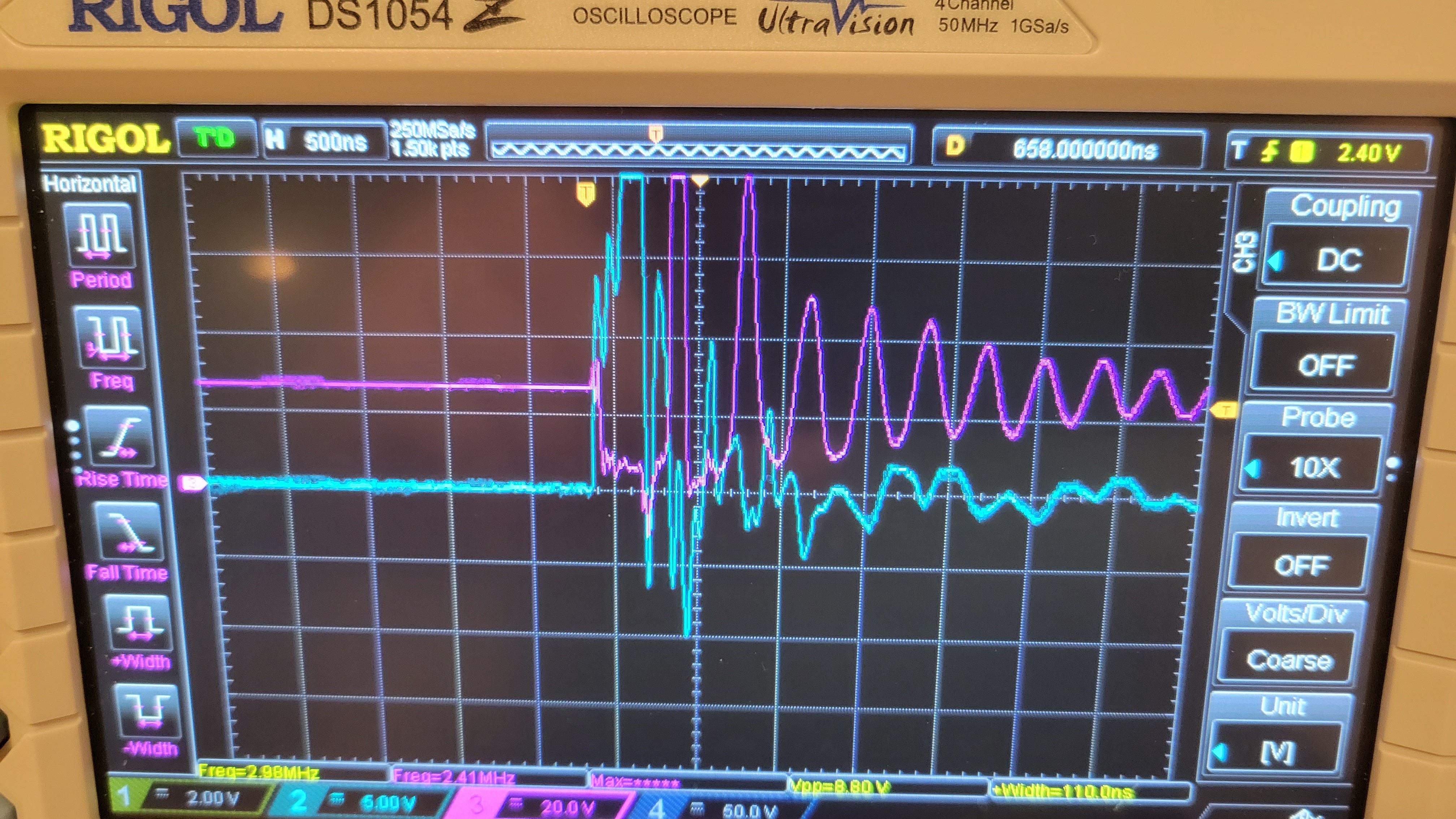
Oscilation!? Why? The MOSFET'S gate is at 0v, source and drain are cut off. Why something should happen? Well, there are a depletion in the transitor as there is voltage over it. So the coil with transistor makes LC circuit. (Since the depletion layer depends on voltage applied, LC oscilation frequency changes as power supply voltage changes)
Now it's clear why there are some frequencies for the main LC that works and other don't.
If the input coil (and MOSFET) frequency and main frequency are multiple of each other then main LC can build up high voltage, otherwise it doesn't and all the circuit is not working or low efficiency.
Actually, once main LC is connected to the input coil, input coil frequency is charging but at least now we know the range.
So, in my case I've used main coil of 2.4uH and 100pF multi mini capacitor. This LC gives frequency of 10.4MHz.
Main coil dimensions are diameter of coil 32mm, wire diameter 1.3mm number of turns is 9.
RFC coil dimensions are: coil diameter 60mm wire diameter 1mm number of turns is 9, which gives 6uH. Since irfc output capacity is 600pF (plus equivalent capacitance of main circuit is 700uF) and and RFC coil is 6uF the frequency is 2.45MHz, which is 1/4 of main frequency of 10Mhz. 1/3 of main frequency gives the same result of 2Kvolt on main LC circuit. Some manual fine tunning can increase voltage to 2.5Kvolt.
I went back to my previus design. This time I got smarter. I've installed LTSpice simulator, much easier to change values (no more dead MOSFETs). Bought nice 100Mhz scope and high voltage probe. I was ready...
I've started with making Tesla coil schematic on LTSpice. It much easier to understand this circuit in 'clean' conditions.
First part is easy, D1 zener diode and R1,R4 resistors are simple voltage regulator for 15v.
Second part is the oscillating circuit L3,C4/C3. Since C4 is much smaller than C3 (or MOSFET's gate), the frequency calculated from L3 and C4. C3/C4 Makes a voltage divider, thus feedback to the gate.
The L2 is not important as long as it between half of L3 and 10x of L3. But in reality L3 can be one of few values and it's related to L2, wrong L3 value leads to low performance. (low voltage on Vout)
The third and the tricky part is L1, it's not self resonant coil but a 1/4 wave resonator.
There is a nice video I made about it
PCB of this Tesla coil can be found on:
I didn't want to give up on this project, so I continued the research and found various Tesla coils I can buy on eBay.
The first was NPN transitor based and made little plasma discharge.
Although it was functional once scope disconnected, I had no idea how it worked in real time. Plus my scope at the time 'Hantek BE6022' made strange reading, that when I started to suspect that my problem was not in devices but my tools!
It took me sometime to start this project again from different angle, now I've tried coupling using coils instead of capacitors
I've used this schematic, the problem here was that the main coil is really bulky.
Again it was not so powerful as I expected but it was a start.
There is a spark but no flame, tried changing confirmation/coil values most of the attempts resulted in dead MOSFETs.
This project started two years ago. If you search on youtube for 'plasma flame' you will get a video that explains how to create it. Those videos are so AMAZING. I wanted to do one myself.
And boy it seems so easy... one mosfet, two coils (you can make them yourself) two capacitors, zener diode and few resisters.
Build the circuit, plugged in 24v power supply and nothing at least no plasma flame and no electro-magnetic energy that could light neon light.
So I went to Danny. Danny know everything about electronics, (he built his first transformer from wires when he was kid, now when he is about 80 with long resume including long list of government secret projects), he was the right guy to solve it in a glance. Next day I asked him for help showing him the schematic and what I've build. It's seems ok, check if there are fluctuation on the power supply he said.
Next evening I've checked for fluctuations on power supply, nope it's not it.
"What can it be?" I've asked Danny the next day. Danny went to a drawer and gave me some device. "What is it" I've asked? You can measure your coils and capacitors values with that.
Next evening I tested all components, the main capacitor what should withstand 2kV was shown as resistor. WHAT?!
I found out the hard way that not all capacitors are equal. I've used some unbranded Chinese capacitors.
Well that's a start I found some better capacitor, fiddled with coils and ...
I got 200v oscillation, impressive but far from 2Kv I've expected. I had no clue how to continue.
Create an account to leave a comment. Already have an account? Log In.
Become a member to follow this project and never miss any updates
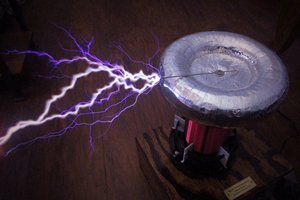
 Zach Armstrong
Zach Armstrong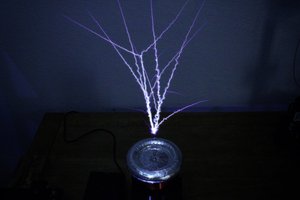
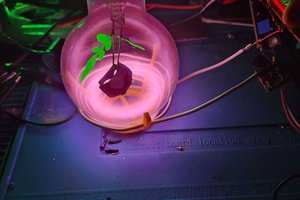
 YSPACE Labs
YSPACE Labs